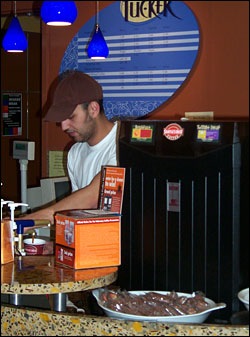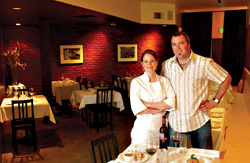Assigned to review the newly renovated dining room in the basement of the UW’s McMahon Hall, I revisited my too-recent college roots with trepidation. My fear proved largely unnecessary, however. The new McMahon dining facility looks like a trendy hotel restaurant. This is hardly surprising, as executive chef Jean-Michel Boulot came to Seattle to run earth & ocean, the restaurant in the Hotel W downtown.
The room’s rambling design is unusually conducive to both casual conversation and hard-core studying. An “art wall” adorned with stained glass smacks a bit of a college dining room trying a little too hard, perhaps, to be stylish. But, hey, at least it’s trying. College dining has entered a major transitional period, and the UW is riding this wave of change. Chef Boulot epitomizes the renewed vitality of university food service; he refers to the students as “customers” and demonstrates genuine enthusiasm about kicking the academic eating experience up to notches unknown.
Example: Boulot took me to visit the herb garden on the rooftop terrace of “8.” Thanks to a partnership between groundskeepers and campus chefs, what used to be a couple of dutiful planters full of low-maintenance grasses now offer both an agreeable sight and a heady mix of herbal aromasthyme, marjoram, lavender, oregano. The effort goes to the heart of what makes “8” a real achievement: You almost forget you’re at a college dining hall.
But what about the food? For our inaugural “8” experience, a friend and I eagerly explored the octet of themed dining “concepts” that give the hall its name. We began by selecting salads from “Wild Greens”: She opted for the salad bar (29 cents per ounce), while I took the adventurous route and ordered a roasted pear salad ($3.75). To fill out our cafeteria trays, we headed over to “Boss Tucker,” where sandwiches and sides are made to order. My companion asked for half a turkey sandwich ($2.75), while I requested udon noodles with peanut sauce ($2.45).
The turkey sandwich came wrapped in orange deli paper, and the ingredients were certainly fresh enough, but the sandwich itself was nothing out of the ordinary. The noodles fared better: The peanut sauce had a well-rounded flavor with a spicy kick, and the broccoli was crisp. The salad-bar salad was more or less what you would expect, while the roasted pear salad offered a nice combination of field greens, flavorful dressing, blue cheese, and walnuts. All in all, a perfectly adequate lunch.
A few days later, we ventured back to “8” for dinner. The only standout was a chicken fajita platter ($5) from “Broiler Zone,” which came with grilled vegetables, black beans, sour cream, and guacamole, as well as two grilled tortillas. This was a restaurant-quality meal, and for five bucks the portion was more than generous. A student could definitely get excited about eating like this on a regular basis.
My final visit to “8” took me and another intrepid companion to “Abundo” (the Mediterranean “concept”) and “Jangar,” a Mongolian grill. The menu at Abundo changes frequently; on this particular occasion, lamb burger with yogurt sauce, orzo salad, and Greek salad ($4.95) and Spanish roast beef with cinnamon-chocolate rub, sweet potato- corn pudding, and green beans with lemon and fennel ($6.25) were among the specials. Opting for something a bit less elaborate, I ordered a plate of farfalle pasta with sundried tomato-pesto cream sauce and mixed vegetables ($6), while my friend emerged from Jangar with tofu, veggies, and wheat noodles ($5.25) and grabbed a prosciutto focaccia sandwich ($4.29) from “Seconds,” the prefab sandwich station.
The results were mixed but not entirely disheartening. The farfalle were pleasingly al dente; some of the vegetables crowning the pasta, however, were just plain raw. The sauce was bland, as the flavor of cream drowned out any tomato or basil nuance. The presentation of the dish, on the other hand, was outstanding. Topped with fresh grated Parmesan, the pasta and a colorful bouquet of vegetables occupied a large bowl whose outer edge was delicately sprinkled with parsleycertainly more than the average college cafeteria is willing to do in the way of aesthetics.
Unfortunately, the Jangar dish suffered from bland tofu and too-chewy noodles. Undeterred, my friend turned to the focaccia sandwich, perking up at the appearance of olive tapenade but eventually finding the bread soggy and the prosciutto utterly pedestrian. Gastronomic ambition is more than welcome when it comes to freshly prepared meals, but going gourmet with the grab-‘n’-go sandwiches may be more trouble than it’s worth.
College dining halls rarely get much respect from the larger communityor need to try for it, since their audience is about as captive as they come. But “8” is not only trying to keep student diners on campus; open to all comers, as the new, improved Husky Den in the student union building always has been, it aims to bring off-campus eaters on. Despite its considerable glitz and admirable attempts to turn burger-addicted college kids into campus epicures, “8” is unlikely to attract members of the nonacademic populationexcept, of course, for those somehow associated with UW profs or students. There are just too many adventurous, reasonably priced dining choices in Seattle for a fancy college mess hall to compete. On the plus side, chef Boulot assured me that visiting luminariesguest lecturers, touring authors, foreign heads of state, famous alumniwill find “8” extremely impressive. So while the new-and-improved McMahon food court may fail to entice the eating public at large, it seems quite capable of feeding students creatively and dazzling potential donors. If you must go back to college, just for a day, there are certainly worse places to chow down.








